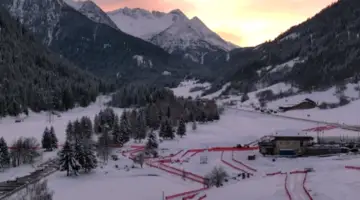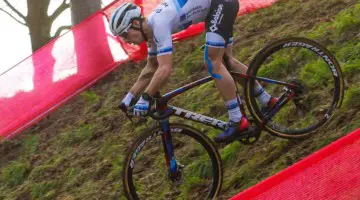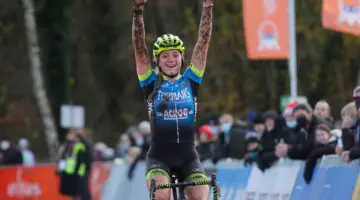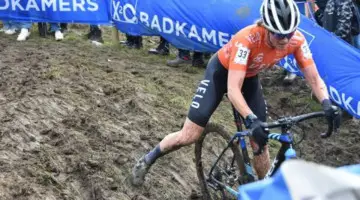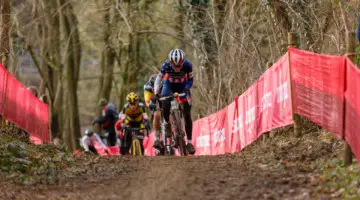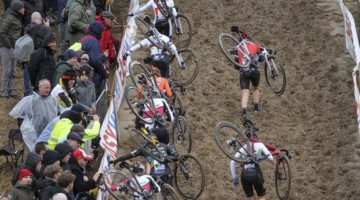This is the first in a series of monthly articles contributed by Corey Coogan Cisek of the “Cyclocross Apprenticeship.” Throughout the cyclocross off-season, she will interview selected pros regarding their preparation. As a coach herself, Coogan Cisek seeks to translate what the pros are doing into actionable advice. Assuming that #crossiscoming, what should you be doing to prepare?
How the Pros Train – Anna Kay
First, a little background on Great Britain’s Anna Kay: It’s likely that U.S. fans first became aware of Kay at the Jingle Cross World Cup where she finished 12th overall and earned the U23 World Cup leader’s jersey. Furthermore, she significantly bettered that result in the following day’s C1 where she was sixth. It was Kay’s first trip to the U.S., and first introduction to our audience, but her performance here did not come as a surprise to those who witnessed her emergence in Europe during the 2018–2019 season.
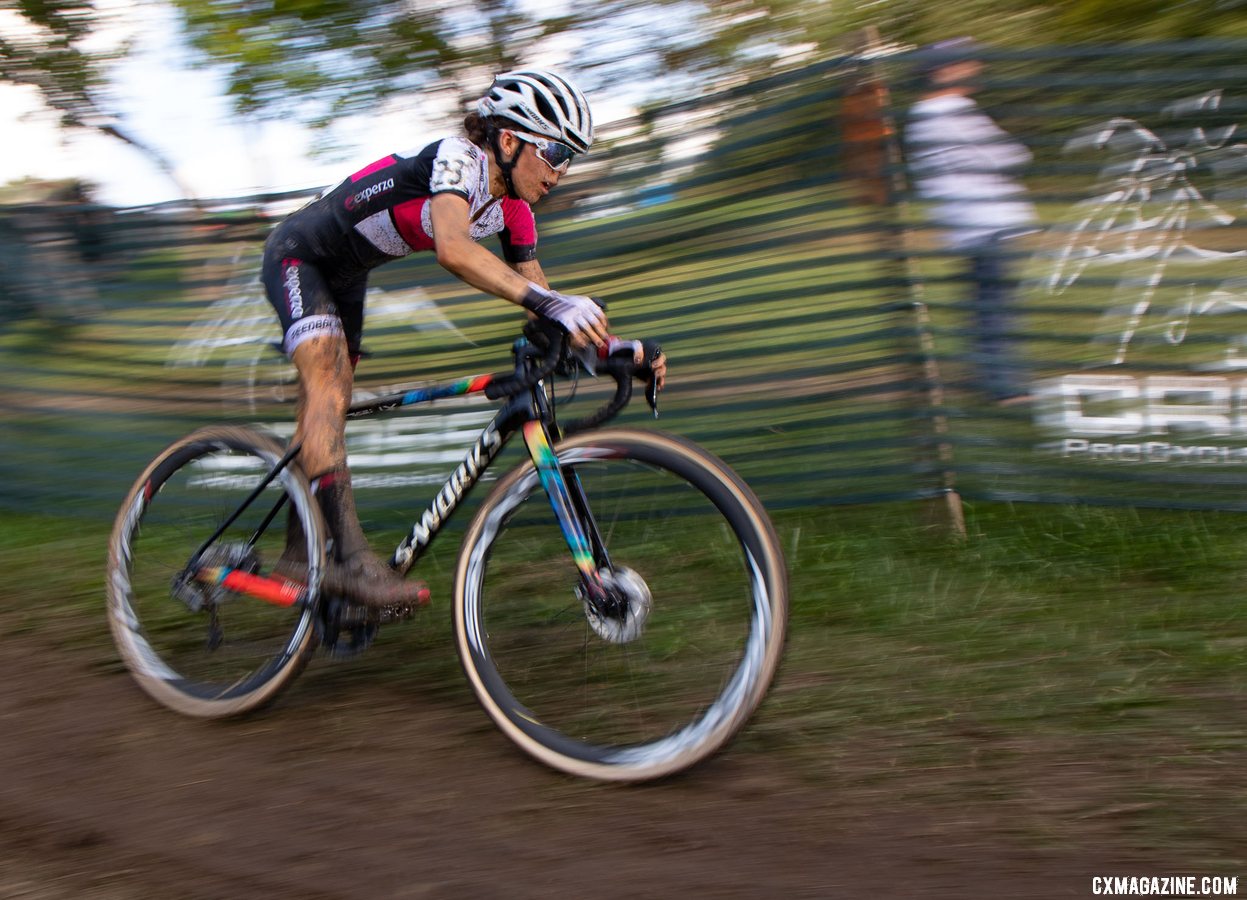
Anna Kay had a strong ride as top U23, and finished fourth. 2019 Jingle Cross Sunday UCI C1, Elite Women. © A. Yee / Cyclocross Magazine
In October 2018, Kay traveled to Belgium for a racing block, representing the British team Storey Racing. She tore it up, posting three top-10s, a 15th and a 16th in three weekends of racing. The reward? A contract with the team then known as Experza-Footlogix and the opportunity to spend most of the rest of the season competing in Belgium. At the time, she was 19 and taking a gap year after completing secondary school.
Kay further wowed British fans at the 2019 British Nationals by dueling with Nikki Brammeier for the win until Kay dropped and jammed her chain late in the race.
Fast forward to last season. After stellar results in the U.S., Kay scored her first World Cup podium with third in Bern, was the U23 silver medalist at European Champs, earned three elite podiums in Belgium and was third in the U23 Women at the 2020 Cyclocross World Championships. It was, by all accounts, an amazing season for Kay. She has re-signed with Starcasino Cycling Team, the team formerly known as Experza-Footlogix.
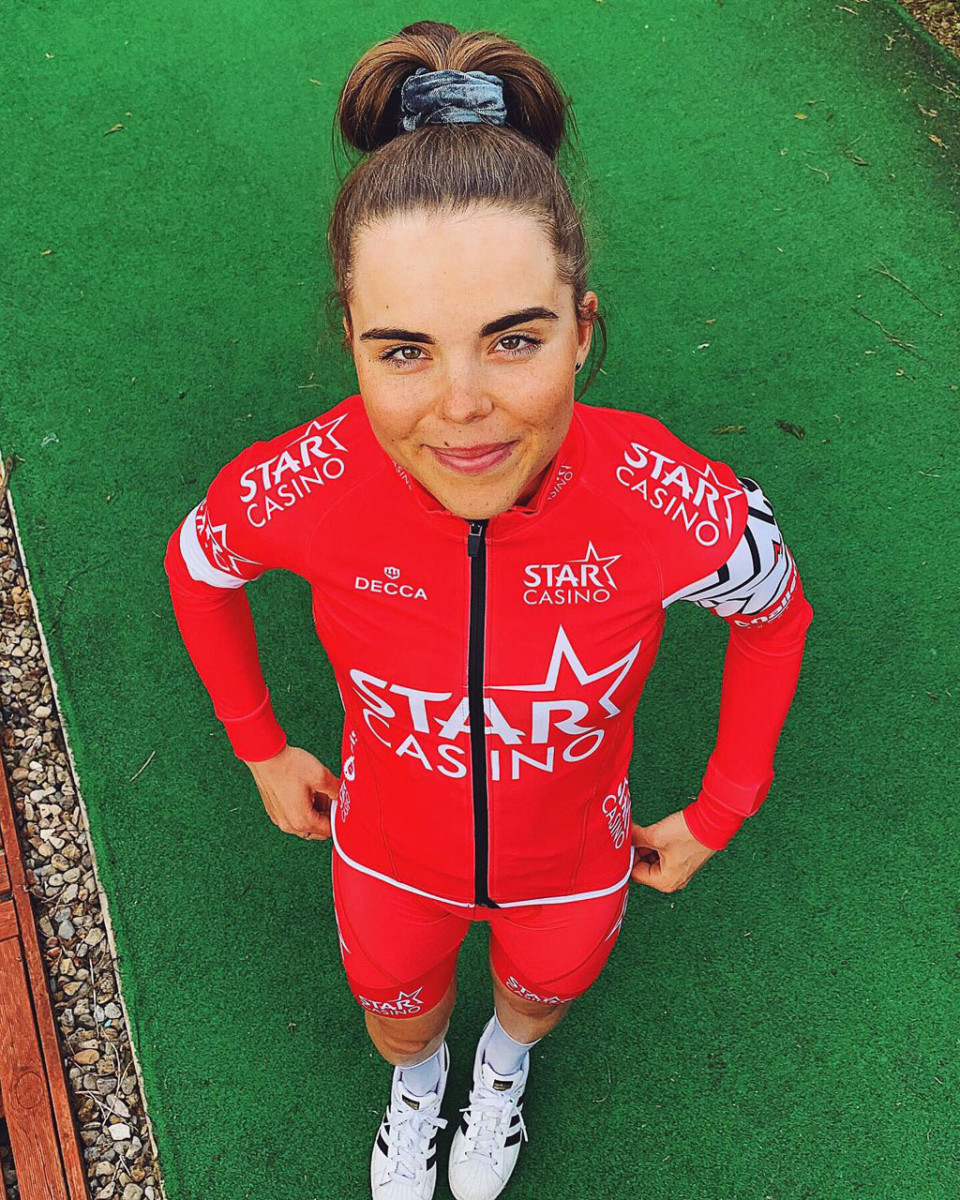
Anna Kay enjoys her offseason as she readies to fly the new colors of her Starcasino kit during the 2020/2021 cyclocross season. photo: courtesy
Kay’s Off-Season
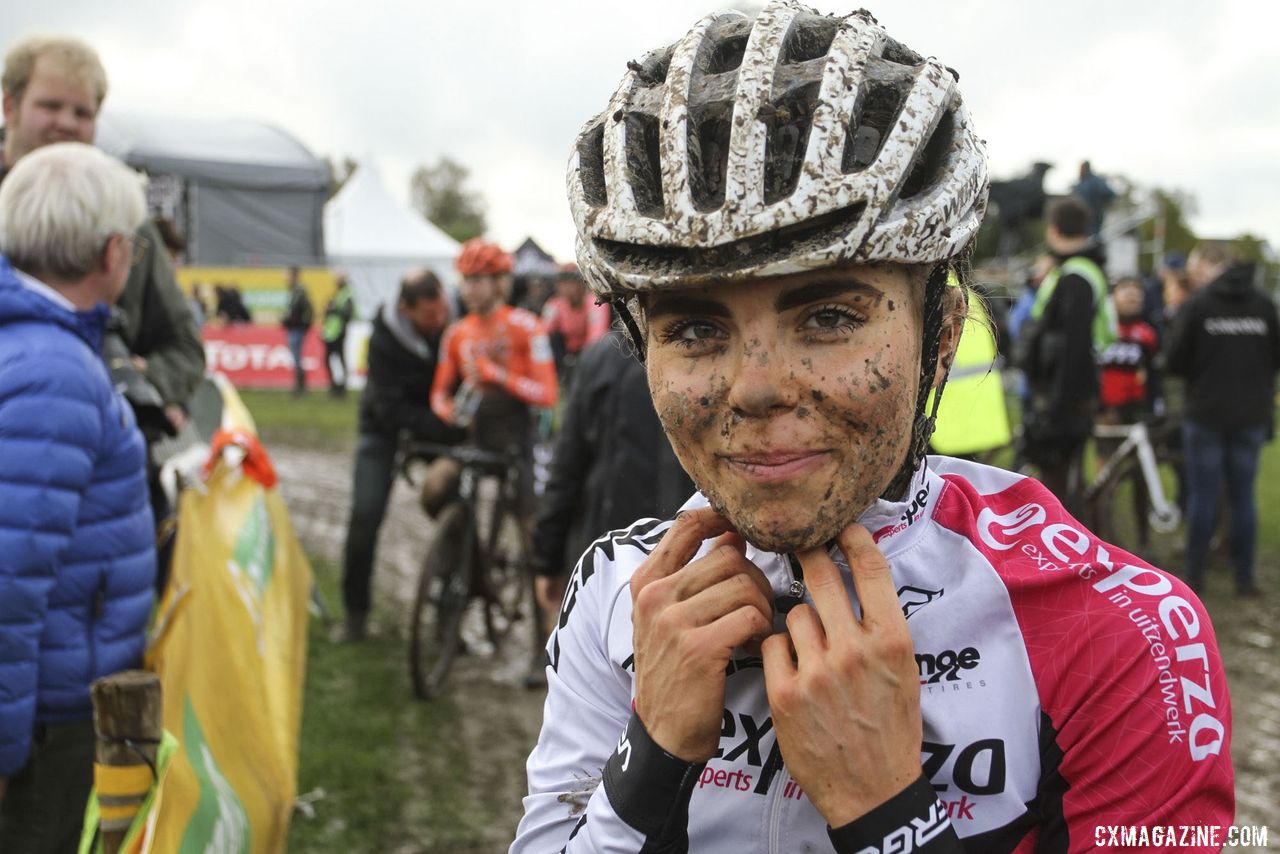
Anna Kay started strong before a crash set her back. 2019 Superprestige Ruddervoorde. © B. Hazen / Cyclocross Magazine
Kay’s stellar season ended February 16th in Hulst, where she took fourth. After that, she did what all good athletes do: she took an off-season.
The length of professionals’ off-seasons varies greatly, from say, two weeks to six. Likewise, the composition of their off-season varies. Some ride for fun and without structure, while others get off the bike entirely.
Kay’s off-season was on the short side, two weeks, but was totally off the bike. During that time, her coach, Stefan (Stef) Wyman, has no “rest rules” other than to stay off the bike. She’s welcome to walk or swim or otherwise be active, but it’s an opportunity to get some mental rest and distance from the bike. Kay did plenty of walking and some core and yoga and gym. After a hectic season, she enjoyed “doing some normal stuff,” eating good food, shopping with her twin sister and spending time with her boyfriend.
Because Kay’s off-the-bike time was short, her return to riding was low-key and patient. In fact, her first two weeks on the bike were as much about fun as they were about getting her cycling legs back. She and her boyfriend, Ben Turner, did a two-week training camp at the Wymans’ home in Rennes-les-Baines, France. (Yes, that Ben Turner: 2017 World Juniors bronze medalist and rider for Alpecin-Fenix.)
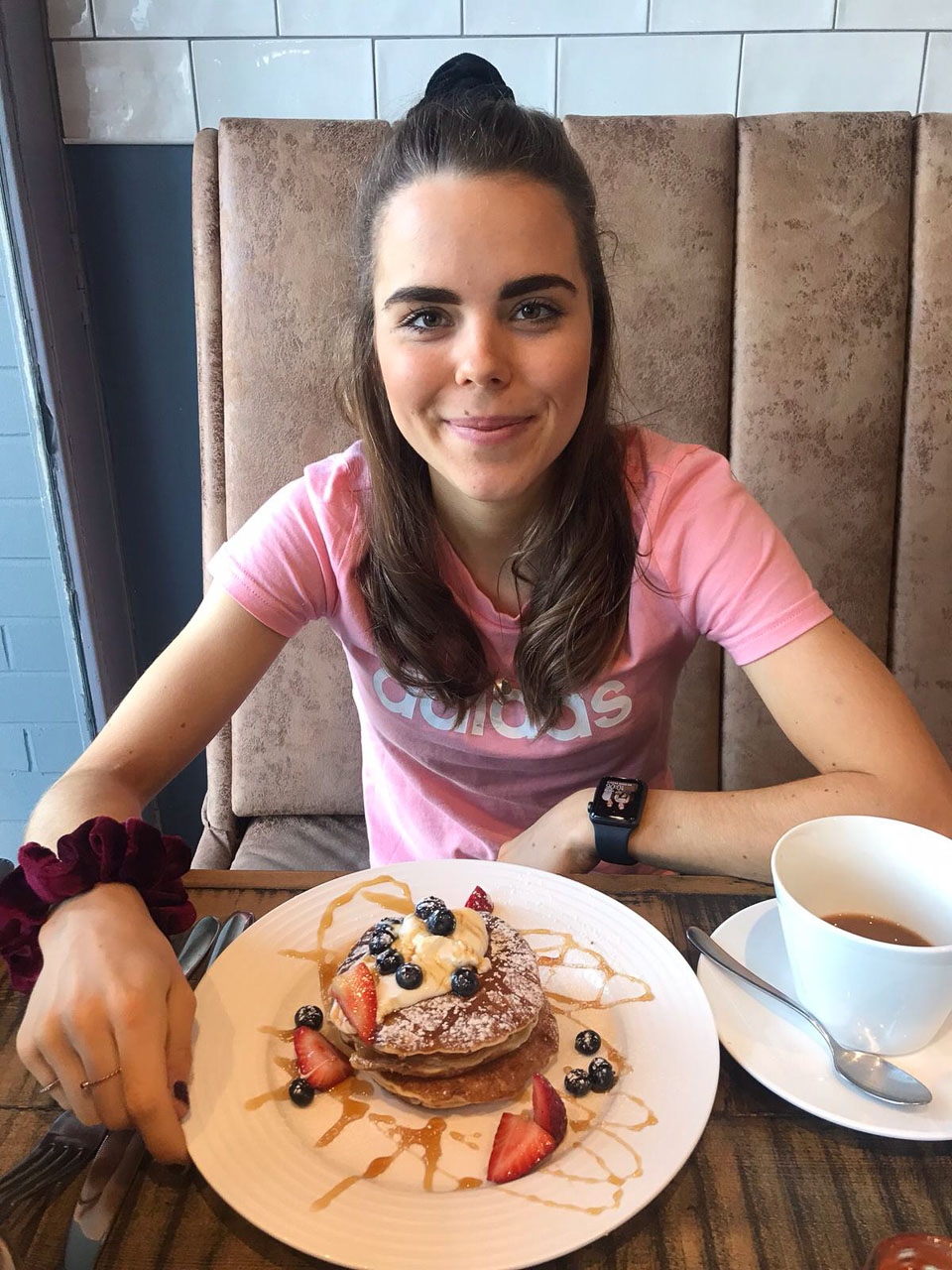
Anna Kay enjoys her offseason as she readies for the 2020/2021 cyclocross season despite the COVID-19 pandemic. photo: courtesy
Anyone who follows Helen Wyman on Instagram can ascertain that Rennes-les-Baines is idyllic with year-round mild temperatures, quiet roads and lots of climbing. Kay’s return to riding was in mid-March, a less-than-ideal month for training in Great Britain. Kay explains, “The idea here was that I would start my training back up, after some time off, in an amazing place with a lot nicer weather!”
Coronavirus Locks Down Europe
Of course, then the novel coronavirus made its impact felt in Europe. Kay said, “We were planning to stay 2 weeks but ended up coming home after 11 days. In fact, we just made it home. We changed our flights, but they were temporarily canceled the day before departure. Then, that night, they were rescheduled, so we managed to get home!”
Having trained in France, where riders would ultimately be banned from riding outdoors, Kay is all the more grateful for the lesser restrictions of the U.K. Until recently, U.K. residents were limited to travel outside once daily for exercise and essential travel only. These restrictions were flexible enough to allow for fairly normal training. The constraints were also a bit offset by the fact that the U.K. spring has been significantly warmer and drier than normal. (As of Wednesday, May 13, U.K. residents are no longer limited to the one-a-day exercise limits.)
Looking forward to the coming season and considering the impact of coronavirus, Kay says her focus is unchanged, “I’m just training as if there is a cyclocross season coming.”
Putting in the Base Endurance Miles
Back in England, Kay spent much of April doing base endurance training. She was happy with how it went, saying: “It’s been a lot more miles than I’ve ever done really. I’m quite pleased with how I’ve dealt with the load.”
Kay began working with Wyman in 2019, so it might seem a bit of a surprise that Kay has relatively little experience with volume. However, she had an injury last spring that impacted her base-building phase. Kay said, “Last year, I missed out on a proper endurance block at the beginning of training season as I had a bit of a knee injury in April and March. I worked more on strengthening my leg than endurance. It’s been quite nice to get base in this year and see how it will help next season.”
Some might be surprised by the amount of base endurance that pros do. After all, one of the selling points of cyclocross racing is that it’s short and sweet, suggesting it doesn’t require as much training time as other disciplines. To a point, that’s true. Obviously, it takes far more training to just get to the finish line of the multi-day stage race than to complete a 45-minute cross race. However, when it comes to being as competitive as possible, just training intensity without base volume has limited efficacy. One can only get so fast without the physiological gains of base training, and the “peak” that results from high-intensity training can only be extended so far.
Kay explains it this way: “It’s good to spend time doing base endurance training. Just like in any other discipline or endurance sport, you need a base fitness in order to build on it. Although a cyclocross effort is well above endurance pace, the higher your endurance base is, the higher your threshold and power will be!”
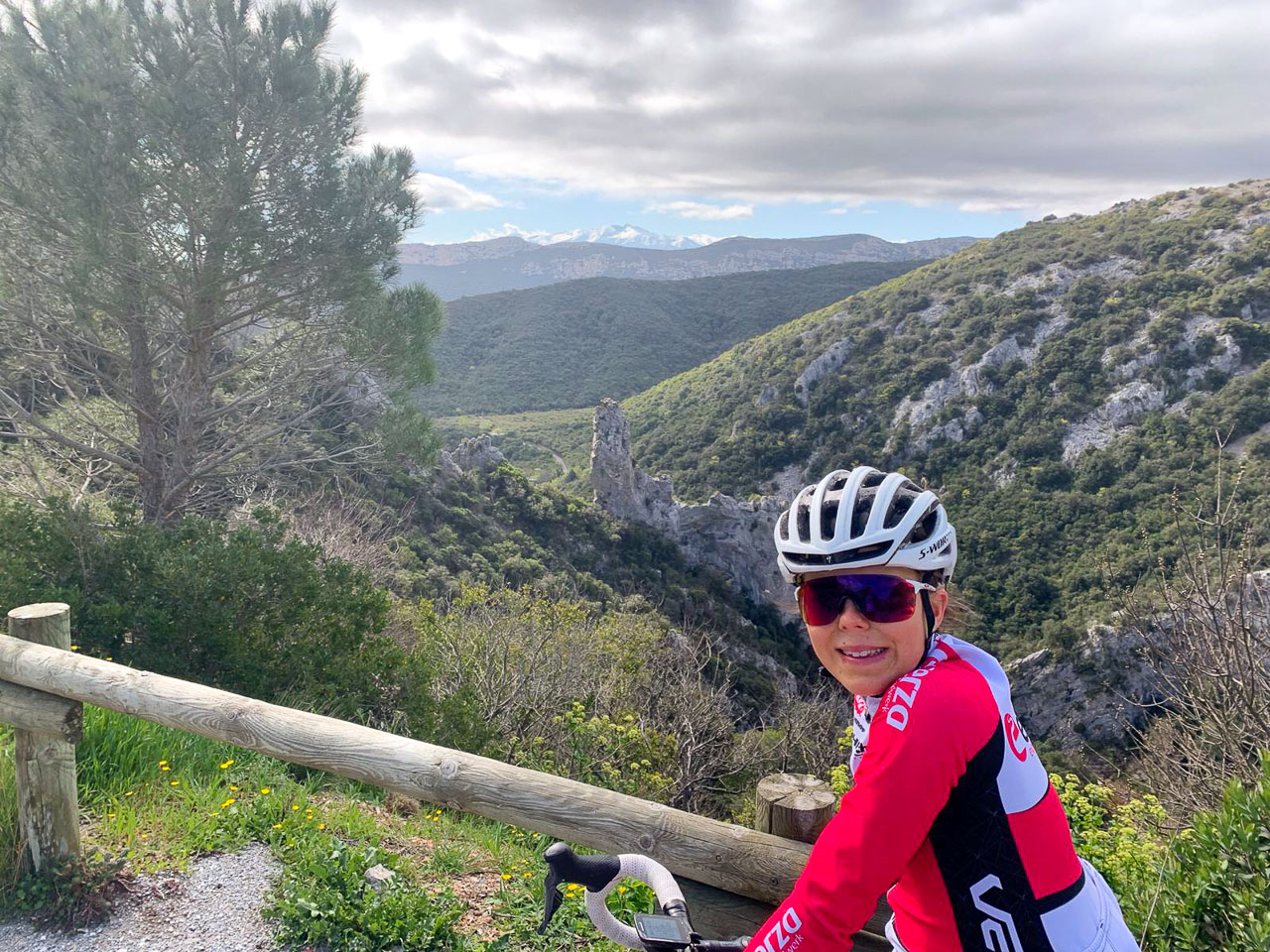
Anna Kay enjoys her offseason with solo endurance miles as she readies for the 2020/2021 cyclocross season despite the COVID-19 pandemic. photo: courtesy
Given the lockdown and prohibition against group rides, Kay has invariably put on plenty of solo base miles. Luckily, Kay hasn’t found long solo rides boring. Kay said, “I’ve found the endurance miles bit of training really fun, as I got to plan some really cool routes on roads that I’ve never been on before. I’ve explored so many more parts of where I live now and know the roads so much better! Previously I’d get lost within 15 minutes of home, but now I’m a lot better!”
Kay also finds time to enjoy the view and daydream a bit on endurance rides because she tends to pace herself by feel rather than be a slave to her computer. “I know when I should be pushing a bit more on a climb. I try to enjoy riding down the descents instead of always trying to push to a power/keep a certain heart rate.”
Amateur riders might struggle to ride easily enough by feel. However, Kay points out that besides learning appropriate pacing via training with Helen, she also has Stef to check her. If she overdoes it, Stef will pull her back. “I’m lucky to have Stef as he reviews my files regularly. He can tell if I am showing signs of fatigue and will give me a few easy days to compensate,” said Kay.
As April drew to a close, Kay’s training became slightly more focused and specific. With her first base block behind her, she’s ready to take the next steps towards the coming season. She said, “In the last couple of weeks, we’ve built in a bit more structure, so some longer efforts/sweet spot stuff, a few sprint sessions, but we are still keeping on the endurance too.”
Addressing Weaknesses
Despite a stellar season, Kay can still point to weaknesses that she and Stef are keen to address: “My primary weakness is pure power for sustained lengths of time, like over a really flat, long section of course. All that endurance base, as well as the longer interval efforts I’m doing now should help! We are also trying to build my upper body strength a bit via both mountain bike endurance riding and gym sessions.”
Kay recognizes that she will gain strength as she grows older and develops as a rider. She is currently just 21 years old and remains a U23 rider (with one last shot at a rainbow jersey) for the coming season. She’s typical in that physical strength and sustained power are often weaknesses for a young person. Simply maturing and accumulating time on the bike and in the gym will increase her strength and power.
Next Generation Skills
When asked to name top-15 women who can jump the barriers, Anna Kay’s name often comes up.
Ellen Noble broke the barrier of women bunny hopping barriers and she is one of very few among her generation to regularly bunny hop.
Kay, while notable for bunny hopping near the front of the race, is not an “exception” among her “U23 classmates.” As I’ve reported before from Europe, U23 females and juniors are bunny-hopping with some regularity. Very soon, it will become an essential skill on the women’s side.
So, how did Kay earn her formidable technical skills?
While bunny hopping barriers is a rather new skill for Kay (Stef taught her last summer.), she’s had years of skill development to get to this point. Kay said, “I started as a mountain biker riding in the forest with my dad,” she explains. “I was brought up learning different skills from him, like bunnyhopping logs and skidding. Even before that, I’d always mess about in the street on my BMX bike with my friends, jumping off curbs and steps and just having fun on my bike.”
Kay also benefited from Great Britain’s strong club system. At age 13, she joined her local club, the Hetton Hawks Cycling Club. The club provided formal coaching for road, mountain bike, and cyclocross. Yet Kay also absorbed a lot informally: “I loved learning from my friends and the coaches, picking up different stuff from different people! I really progressed because of the club!”
The Takeaways
First comes rest and then comes base. Taking a rest block after the racing season is critical for both the mind and the body, but there is no one right answer in terms of length and activity levels. If you did not take a rest post-season, you could still take one now, when racing is not happening anyway, before you build towards cyclocross season.
Have a plan to address your weaknesses. Both you and your coach should be on the same page regarding your weaknesses. You should have a clear plan to address your weaknesses and should be already starting to implement it.
The skills of U23/junior female riders succeeding on the world stage are next level. A junior rider’s training should be part skills development and part fitness development with more effort devoted to the weaker of the two. And for those of us who are not U23/juniors? It’s never too late for old dogs to learn new tricks!
Corey Coogan Cisek is a Minneapolis-based cyclocross racer and coach who has spent much of her recent cyclocross seasons racing in Europe. Learn more about Corey at tripleccoach.com.























